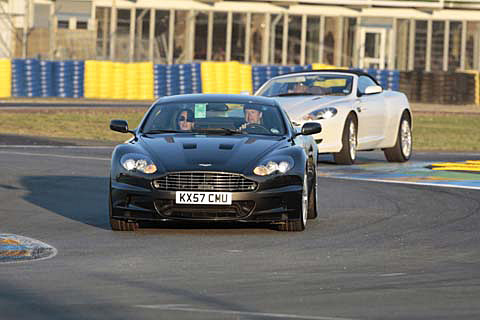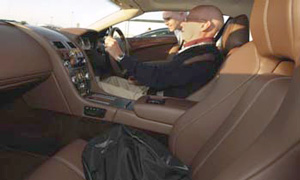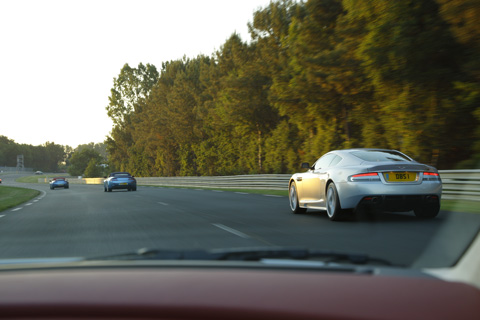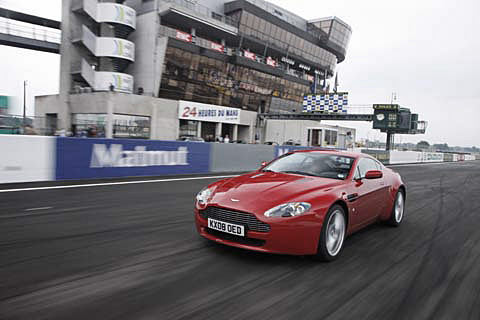
Following Le Mans veteran Oliver Mathai, in the Aston Martin DBS, through the Ford chicanes in Aston’s 2009 V8 Vantage.
Aston Martin’s latest V8 Vantage benefits from 80 years of development for the 24 Hours of Le Man and we chase its history on the storied circuitton
Photos by Nick Dimbleby, Pete Robain and Ian Dawson
Cornering hard into the Ford Chicane–second gear–very tight. How do the LMP cars do this? We have entered from a back corner of the paddock and it is a curious place to begin a lap. Full power up the long hill past the pits, all the way to top gear; two quick clicks down to fourth at the top of the hill and into the new Dunlop curves surrounded by acres of gravel and quickly to the esses and the forest.
The old trees are nearly dead ahead as we clip the series of red and white apex curbs through still more gravel fields. The forest is cut so far back now that neither it nor the famous waddle walls are represented in these historic corners. The Vantage shift paddles are within an inch of the wheel and edged with a rubber grip. One finger does the trick and the changes are instantaneous and musical as the computer matches the revs in the sonorous new 4.7-liter V-8. Trying to corner quickly during the first mile in the car is a struggle, but the grip in both the tires and the seat inspire a certain amount of comfort.

Settling in to the new V8 Vantage for a
couple of memorable laps of Le Mans.
A circuit safety car, an Audi RS4 wagon, is our guide and pacesetter. The Audi is hard away toward Tertre Rouge. A DBS follows it closely, driven by Oliver Mathai, who co-drove a Vantage N24 to a class win at the recent Nurburgring 24 hours with Matthew Marsh and Shini-Ishi Katsura. My Vantage was at full song and back up to fifth trying to stay close to the DBS. Tertre Rouge is hardly recognizable. It has become two very fast down hill 45degree corners to set up for that legendary straight past Cafe l’Hunaudiere down to Mulsanne, presumably, to permit lap times to approach the circuit records before all the new chicanes. Wind and tire sounds begin to grow as we pass 160 k/ph. The Vantage loves the wind. It is settling close to the road and feels locked on. I can feel the surface in the wheel, but it doesn’t really move, just offers confidence the tires will communicate clearly when they’re asked to work hard.
We are kept to a little above 220 k/ph. That is fast enough to challenge our approach to the first chicane. The Vantage 13-5/13-inch front/rear brake rotors have not changed for the new car and are all one could ask for this quick tour. The Audi and the DBS both do the chicane at the edge of the curbing. I follow by one car length using a bit more curb in search of a balance between the Vantage ability and mine. The rest of our group began falling behind at the esses and are now too far back up the straight to see in my mirrors. Pressured by the DBS and one Vantage, our Audi guide ups the ante as we click back down to second gear and run through the second chicane in line astern. The entry is tight, but the exit opens into a fast sweep. Mathai is a real Le Mans veteran in a very fast car, but he is being constrained by the RS4 that allows me to stay with him. After the chicane, at our speed, the old kink is no challenge. A roundabout has replaced the intersection historically called Mulsanne corner. Now a smaller kink of race-only tarmac takes you 15degree right to avoid the traffic circle. With two quick down changes I have fourth gear quickly matching revs with musical accompaniment for each ratio. The engine’s cylinder bore and stroke dimensions have gone from 86/89 to 91/91 to increase the swept volume by 400 cc. In conjunction with a long list of revisions, the torque curve has been raised across the rev range with the output between 3000 and 6500 up by 15%. Horsepower is up from 380 to 420 at 7000 rpm, but the torque has made the car feel far more responsive; even lighter. The last generation 4.3 Vantage was always fast, but never felt as light on its toes as this one.
The exit of the new Mulsanne turn is a full power sweep. The infamous sand bank is gone, with few complaints, I’ll wager. It is fun to follow the DBS V-12 back up to top gear. It’s a fast run to Arnage. There are a couple of long bends en route but not to be considered at our speed. Even so, at some point we will have to collect our non-racer colleagues who have no idea how to drive at even this 8/10 speed, but, hopefully, not until we can finish this delightful lap. A touch of brake is needed for the fast right kink that leads to the left traditionally known as Indianapolis. This historic corner is flat in third and wider than I expected, but the right at Arnage comes up quickly and is a narrow right turn at a rural intersection that requires a busy paddle, all the way down to first for a few seconds or low revs in second.

Paul Dean, an experienced driver, has had enough following and makes a run to catch the lead group.
There have been comments about Aston’s artful instrument design with brushed metal background and three-dimensional graphics; now at speed with only time for a periodic glance I recognize the problem. The numbers are clear and simple and large enough to comprehend at a glance, but the speedometer and tachometer rotate in opposite directions toward each other. That is a bit confusing when there is so little time to glance at them except on the straights when neither is moving very much. Until you know which way they are going and at what angle the good power is available it can be frustrating.
By the time we exit Arnage and make the sixth gear blast past Maison Blanche, (unfortunately, the cottage is no longer visible from the race-only tarmac through the Porsche Curves) the tach needle position is better understood. The curves are fast and fun for us, but probably taken much more seriously by the racers in traffic. In my mirror I see a red Vantage closing fast. It is senior journalist Paul Dean who was caught behind the beginners for the first half lap. On the run down to Mulsanne, he later told me, he just couldn’t stand it any longer and blasted past everyone. Now we are four.
We brake hard for the Ford chicanes and pitch in. The new aluminum Bilsteins are seriously challenged in these tight combinations. Roll stiffness is better and it makes the car feel quicker to respond and I can hang the front tires from curb to curb with all four corners attached. These look like slow corners, but the Vantage passes over the curbs quickly and stays with the DBS. After watching practice here the night before, I recognize my amateur status; fast, modern cars do these kinks very quickly. Our lead all-wheel-drive RS4 is impressive here with enough power to make full use of its grip and pull us out of the last turn and up the straight past the start finish. Following the DBS at full song is fantastic. Up the long hill it pulls a few car lengths on the Vantage, but that just lets me hear the big V-12 reverberating between the walls fronting the stands. Before we get to the top and into the Dunlop Curve the Audi lifts and pulls us down to wait for our colleagues.
With only one lap completed I consider what great working space is offered in Aston’s smallest coupe. My elbows never came in contact with anything. The newly trimmed console is close enough to reach everything easily and low enough to be out of the way on a busy afternoon drive. Even the foot well is roomy. So many modern cars have fender intrusions that cramp the working space for a good-sized shoe. Not here. There is a good dead pedal and a comfortable distance between the brake and accelerator that precludes any accidental pressing of one or the other when your foot needs to do something quickly. I will soon spend some time in a manual gearbox roadster and enjoy the space even with a clutch included, but with only two pedals it’s like a walk in the park.

Paul making memories on the finishing straight.
I liked the V8 Vantage when I first tried it a year ago; this upgrade has come quickly; the primary change is in the car’s feel. There have been lots of invisible changes and very few visible ones. The bigger engine is the start. A list of replaced or redesigned internal details and components is impressive and has resulted in a more responsive car, but the engine is enhanced by new software in the Sportshift controls and the lighter clutch for the manual gearbox. The performance numbers have only changed a little, but a lap of the circuit at Le Mans exposed an exponential improvement in the fun factor.
You had me sitting right next to you, Larry, enjoying my first lap around LeMans very much…thanks!
Brilliantly detailed accounting of your lap! What a wonderful car to tour the course in as well. Thank you much for sharing your experience.